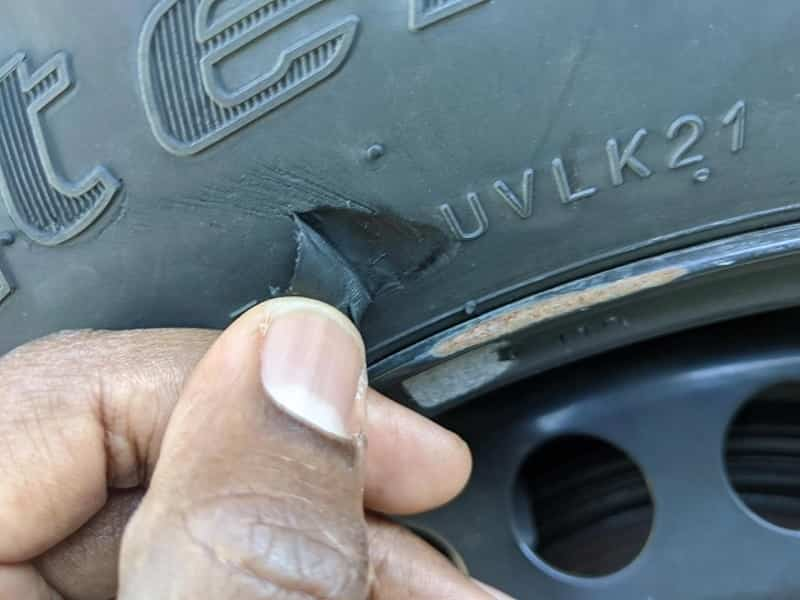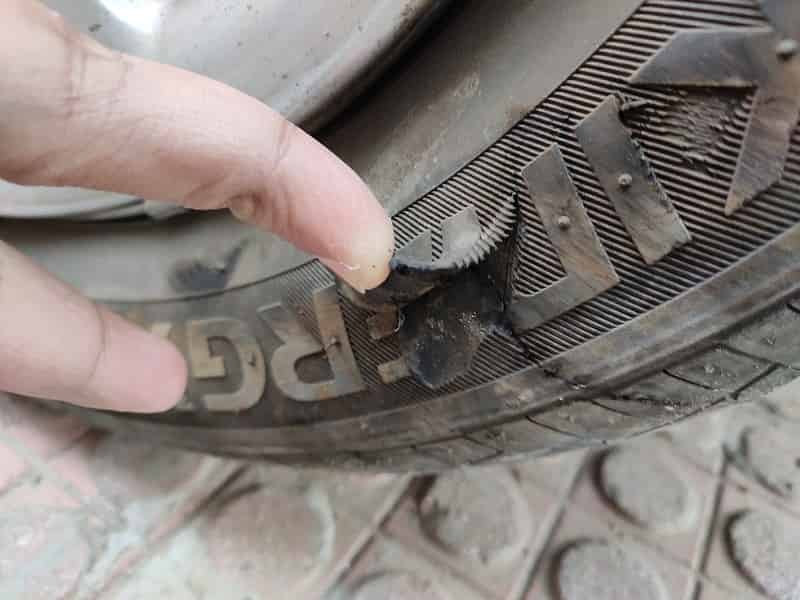Tires are like the unsung heroes of the automotive world. They keep us rolling down the road in style, absorbing all the bumps and potholes that come our way. They're like the cushy sneakers of the car world, cushioning our rides and making sure we get to where we need to go in comfort and safety.
But let's be real – tires can also be a real pain in the, well, you know. Punctures, blowouts, and sidewall damage – it's like they're just waiting for us to let our guard down before they strike! And don't even get me started on the price tag of a new set of tires.
Sure, a simple puncture can be fixed with a spare tire or a tire repair kit, but when it comes to tire sidewall damage, things can get a bit trickier. It's like trying to repair a broken bone with duct tape – it's just not going to hold up. So, what's a driver to do? Can you continue driving with tire sidewall damage?
Well, we're about to find out. So, buckle up, folks, because we're about to take a deep dive into the world of tire damage and see if we can't come out the other side with our wallets intact and our sanity (mostly) intact.
Contents
What is a Tire Sidewall?
The tire sidewall is the vertical part of any tire, i.e., the area from the rim to the shoulders. It is a crucial part of any tire, as it protects the cord plies from damage, and they give any structural integrity. Damaged plies can significantly weaken the construction and lead to instability or blowouts.
But the sidewall itself also supports the tire – its stiffness of the sidewall is directly correlated to how the tire performs. For instance, performance tires are usually more rigid for higher responsiveness and stability, while touring tires have softer sidewalls for comfort.
So, yeah, tire sidewalls are a big deal and not easily fixable. It's like trying to fix a flat with bubble gum – it just won't hold up. Still, there are a few different tire sidewall damages, and not all are created equal. Let's have a closer look.
Different Types of Tire Sidewall Damage
The sidewall can be damaged in various ways, but in any case, it's crucial to regularly inspect the tires to ensure a safe drive. Although drivers don't usually inspect their tires, you could at least ask your tire technician to do that for you. Here are all the different tire sidewall damages you should be concerned about.
1. Chipped or Cut Sidewall Rubber

Chipped rubber on the sidewall of the tire
One of the most common types of tire sidewall damage is chipped rubber. This type of damage usually occurs when the sidewall of the tire comes into contact with abrasive surfaces such as sharp rocks or curbs.
Chips can range in depth from a few millimeters up to a centimeter. In most cases, the cords or plies of the tire won't be exposed, but in some instances, the cords may protrude from the sidewall, especially if the sidewall has been punctured or cut.
Sidewall damage can have serious implications for the safety and performance of the tire. Chipped or cut sidewall rubber can weaken the tire's structure, leading to a potential blowout or a sudden loss of air pressure.
2. Tire Sidewall Cracks

Tire Sidewall Cracks
Another common type of tire sidewall damage is cracking. Unlike chips or cuts, sidewall cracks can expose the inner plies of the tire, compromising its integrity. This type of damage usually occurs due to aging or low-quality tires. Cracks can form due to prolonged exposure to harsh environmental factors such as UV rays, extreme temperatures, and chemicals.
Sidewall cracks can lead to a sudden loss of air pressure, which can cause the tire to blow out while driving.
3. Sidewall Bulge (Bubble)

Bubbles on the sidewall of the tire
Sidewall bulges, also known as bubbles, are a common occurrence in older tires. This type of damage can also occur due to overloading or underinflating the tire. Although sidewall bulges may not look too dangerous, they signify a severe issue with the internal construction of the tire. They occur when the inner cords or plies of the tire become damaged, leading to a weakness in the sidewall structure.
Sidewall bulges can compromise the tire's structural integrity, leading to a potential blowout or sudden loss of air pressure.
Main Causes of Tire Sidewall Damage
1. Manufacturing Defects (Cheap Tires)
The most common reason for sidewall damage lately is cheap tires. Today's market is literally flooded with tires from dubious manufacturers (usually from China) that just emerged on the scene. You can notice that these brands offer unrealistically cheap tires – sometimes three times as cheap as a premium tire!
These companies don't produce the tires in state-of-the-art facilities, nor have good in-house quality control. Not to mention, they also don't spend resources on research and development and usually source parts from suppliers that also don't have good quality control.
As a result, manufacturing defects often happen in these tires and lead to sidewall cracks or bulges. These things can happen in some high-quality premium tires as well, but much less often. Hence, I strongly recommend purchasing tires from reputable manufacturers who actually care about the safety of their customers.
2. Old Tires
Even if you don't drive your car regularly and there is tread left on your tire, the rubber can still go bad after a while. Tires have an expiration date, even if you don't use them at all.
Namely, due to changes in temperature, air humidity, the sun's UV rays, and multiple other external factors, the rubber compound can lose its elasticity over time and become brittle. As a result, the sidewall on old tires can start to crack and expose the internals, leading to potential blowouts.
3. Hitting Deep Potholes or a Curb

Hitting a deep pothole or curb can damage the sidewalls of the tire
The most common tire sidewall damage on newer tires comes from hitting deep potholes, curbs, or sharper rocks. It could also happen if you drive fast over a speed bump, though that depends on how much it protrudes and how sharp it is.
4. Underinflated/Overinflated Tires
Running your tires at the recommended pressure will ensure optimal performance in terms of handling, comfort, and fuel efficiency. However, running them underinflated (or overinflated) will not only hinder your vehicle's performance but it could also lead to sidewall damage.
Keeping your tires underinflated might result in sidewall bulges, as you would put extra pressure on the inner cord plies. Remember – the air inside your tire carries most of the weight of the tire, and not having enough of it could result in various issues. However, too much air could also result in sidewall bubbles, so make sure you don't overdo it as well.
5. Overlading the Tires
Every tire has a maximum load rating, i.e., the heaviest weight it's designed to carry. Putting too much weight in your trunk could overload the tires and lead to sidewall damage. However, it could also damage the suspension components, as your vehicle's maximum weight capacity usually coincides with the tire's load capacity.
Can You Repair a Damaged Tire Sidewall?

It depends, but in most cases, a damaged tire sidewall can't be repaired. The problem is that some tire shops will tell you that the damage is repairable and try to fix it and make it look cosmetically sound. However, the issue might still persist, and driving with a damaged sidewall is a safety hazard.
In my experience, a chipped sidewall rubber that's just a few millimeters deep is repairable, but anything deeper than that is not. And the main issue here is that deeper cuts damage the inner cords, which can significantly weaken the tire's construction and lead to blowouts.
In case of sidewall bulges (bubbles), cracks, deep cuts, or punctures, I'd immediately replace the tire with a new one, even though the tire technician would suggest repairing it. Safety should be the number one priority when driving, not just for the driver but also for the passengers and other traffic participants.
Is it Safe to Drive with Tire Sidewall Damage?
The short answer is that driving with sidewall damage is not safe, and you should immediately take action. The long answer, just like with repairs, is that you could continue driving if the abrasions are not deep, but I'd still advise against it because the chipped rubber can get worse over time.
Meanwhile, if you see bigger cracks, bulges, or cuts, you should immediately stop driving and replace the damaged tire. When not sure, you can ask your tire professional to give you advice upon inspection.
How to Prevent Tire Sidewall Damage
Taking care of your tires, just like you would with your car, will make them last longer and significantly reduce the chances of you getting sidewall damage. Proper tire maintenance is not only key to safety, but it will also save you money in the long run.
So, check your tire pressure at least once every month, or more often if there is a sudden change in temperature outside, and ensure it's always at the manufacturer's recommended value.
Furthermore, make sure your eyes stay glued to the road and avoid hitting potholes and objects while driving. This will not only help you keep your tires healthy but will also result in a safer drive – attention is key when driving! Also, avoid driving over curbs, and when you need to do that, always drive slowly. Lastly, inspect your tires regularly for signs of wear and damage.
By taking these steps, you can help ensure that your tires stay in good condition and keep you safe on the road for miles to come.
Final Words
Although it's a serious safety issue that often leads to blowouts and life-threatening accidents, tire sidewall damage is still not taken seriously by drivers.
I still see too many cars with tires that are unsafe to drive, and it makes me sad because it shows that we don't put enough value on human life. Sure, buying a new tire is expensive, but it's nothing when compared to purchasing a new iPhone, which most people do every two years.
I won't go into a long rant here, but I will still ask you to take safety into consideration every time you hit the road – not only for our safety but also for younger generations!
I’m Ivo Gievski, the content writer for Tireer. We built our website with over 15 years of experience and extensive research in the automotive and technology sectors. My dedication to delivering high-quality content is unwavering, and I strive to continuously hone my skills to stay ahead of industry trends and provide readers with informative, engaging, and valuable insights.
Thank you. I’ve got a chip in my sidewall. When I was poorer, I drove with much worse and had at least one high-speed front blowout that was manageable (don’t brake!). I used to mount 2 grades of tires: May Pops and Will Pops. However, because of your post, I feel it’s not a waste to replace my relatively new front tires, even when the tires, mount and alignment will probably cost ten times what I used to pay for a car when I was in the younger generation.
I have to thank you for making it clear that a monthly pressure check is the key to protecting our tire sidewall from damage. Nevertheless, it would be wiser for my brother to visit a tire shop as soon as possible. Two of his car tires are deemed too dangerous to use anymore after a quick inspection last week.
What ‘few millimeters’ means? 🤔